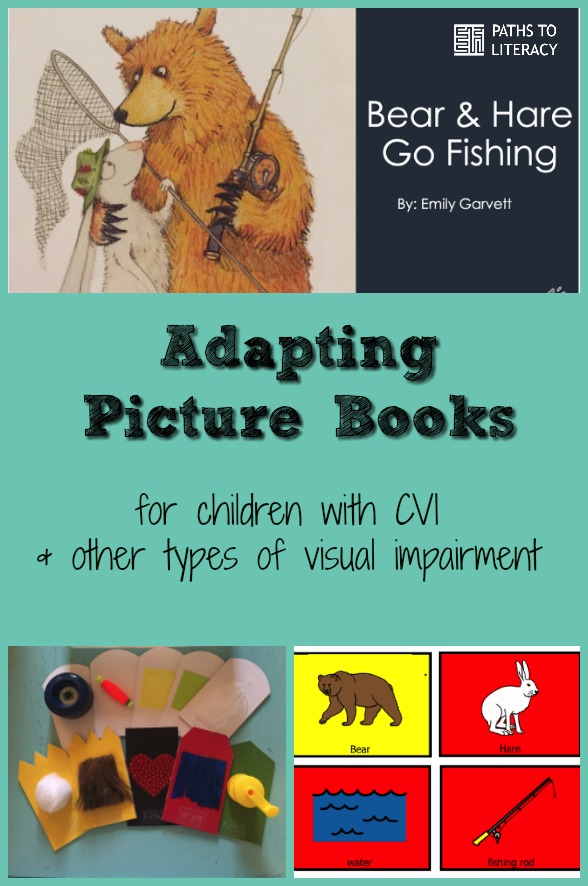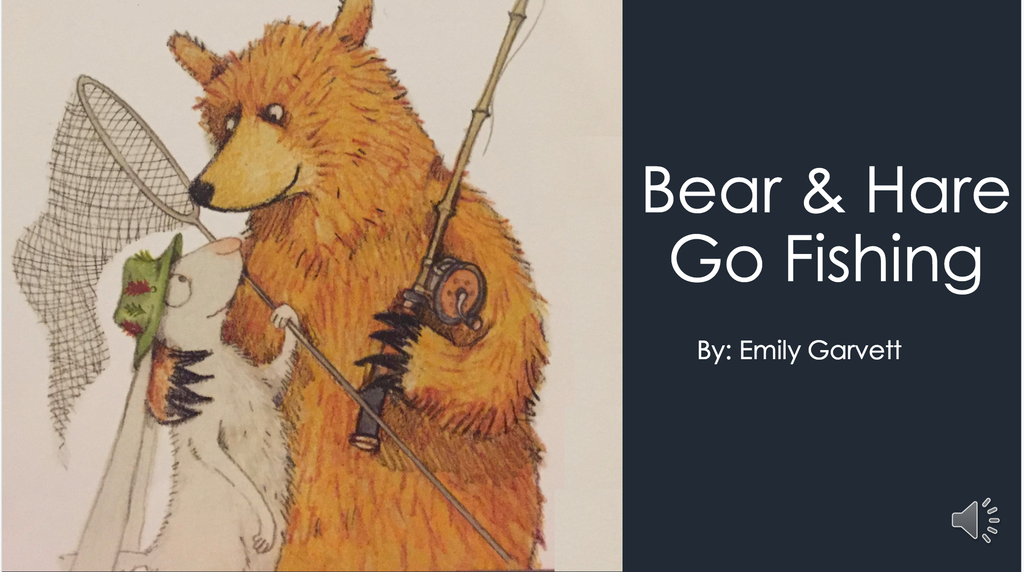Adapting Bear and Hare Go Fishing for Children with Visual Impairments
Submitted by bswi222 on May 01, 2016
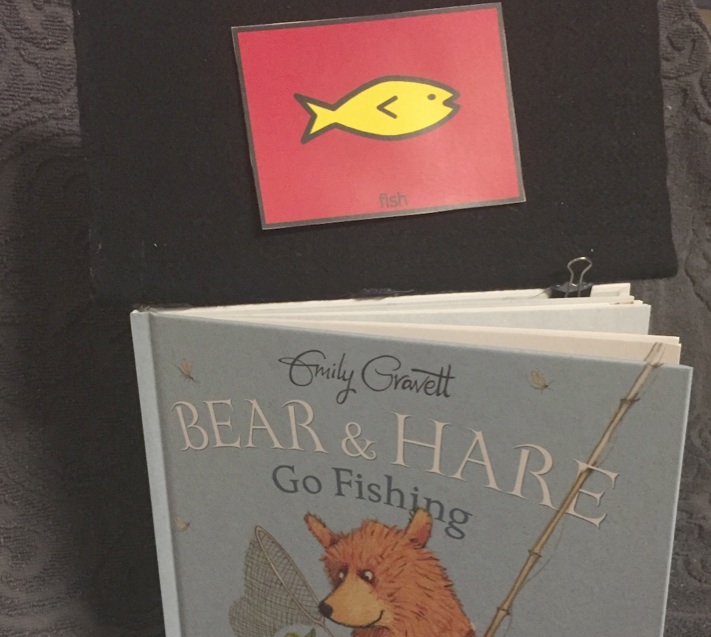
As part of the graduate coursework for Visual Impairments and Multiple Disabilities in the Teacher Preparation Program in Visual Impairments at the University of Kentucky, students were asked to complete four projects: Story Box, Picture Communication Symbols for Story Box, Tactile Communication Symbols, and Talking Book Project.
We are sharing them on Paths to Literacy and hope that others will use them! Please add your comments at the bottom of the page.
- Story Box
- Picture Communication Symbols for Story Box
- Tactile Communication Symbols
- Talking Book Project
Story Box
I chose to do a story box for the book Bear & Hare Go Fishing by Emily Garvett. It is a fairly simple book but I really enjoy all of her work. I thought it would be nice to have a simpler book for my younger students. One challenge is the fact that so much of the story is being told through the illustrations. While this was a challenge it also gave me a great idea, I could utilize the Talking Book even more than I had originally planned. The “alt text” describes each picture from the book giving the reader a better understanding of the story as a whole.
A student might need some background knowledge of fishing before starting this book. Knowing some of the fishing gear might be beneficial although I have included some items in the box. Basic knowledge of a bear and a hare (possibly that a hare is a rabbit) might be good as well.
 The first items I included in my tackle box are a bear and hare figurine. Although these are small, tactually a student would be able to get a basic interpretation of the animals. Since these are made of plastic/rubber materials, I also included a piece of fur for Bear and a pom-pom for Hare. These are to help the student understand that these animals are covered in fur. I also included a pair of “bunny ears” for the student to explore. These are on a headband and the student could wear them. I thought this would help with understanding that hares have long ears. Next, I included a fishing rod and net. Bear uses both of these during the story. I thought it was important for the students to feel a real fishing rod with working reel and a net.
The first items I included in my tackle box are a bear and hare figurine. Although these are small, tactually a student would be able to get a basic interpretation of the animals. Since these are made of plastic/rubber materials, I also included a piece of fur for Bear and a pom-pom for Hare. These are to help the student understand that these animals are covered in fur. I also included a pair of “bunny ears” for the student to explore. These are on a headband and the student could wear them. I thought this would help with understanding that hares have long ears. Next, I included a fishing rod and net. Bear uses both of these during the story. I thought it was important for the students to feel a real fishing rod with working reel and a net.
The next items are the things that Bear “fished” including a fishing hat like Hare’s, a “frog” and a roller skate. The hat is something the student could try on and feel the wide brim, bobbers and lures that are attached. I felt like the roller skate was something that a student might not have any knowledge of and it was important for me to include one for my students to explore. The frog is a toy but the student would be able to get an idea of what a real frog would look like. Since a fish would be quite difficult to have, I found a fishing lure that looks and feels like a fish. This may not be idea but it would open up a discussion on fish and how they look and actually feel.
The last items I included are things that are not mentioned in the story but are found in the illustrations and Talking Book. I thought they were important to include to reinforce the concepts in the illustrations. I included “bait worms”, a flower and a snack. There are all items Hare is keeping himself occupied with while Bear fishes (and naps!).
Five Ideas for Implementation
-
Creating Tactile Understanding
By implementing this story box, the student will gain an understanding of the objects in the box tactually and will hopefully an understanding of the story overall.
-
Use with Talking Book
As mentioned before this story box will be best utilized with the Talking Book. The book uses the illustrations to help tell the story. The objects I chose will help tell the story like the illustrations.
-
Recreate Story
The students will be able to use the objects to recreate the story. This will reinforce concepts within the book. The students would be able to “fish” for the items using the real fishing rod or the toy one to fish for the magnetic fish.
-
Sequencing
Students will be able to use the objects found in the box to sequence the events of the story.
-
Comprehension
Students will be able to use the objects in the box to answer comprehension questions. The objects will also help them understand the tactile communication cards.
Picture Communication Symbols for Story Box
The pictures that I chose coordinate with the story “Bear & Hare Go Fishing” by Emily Garvett. I have 15 symbols that I thought represented the story that can be used to answer the questions. There symbols can also be used to retell the story. The symbols are mounted onto the matting board to make them sturdier. I made a felt board that clips onto the back of the book so that the symbols can be placed with Velcro onto the board while the story is being told.
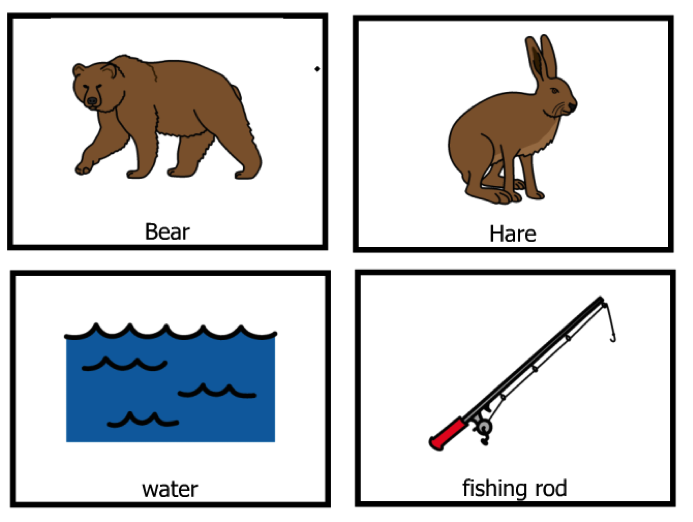
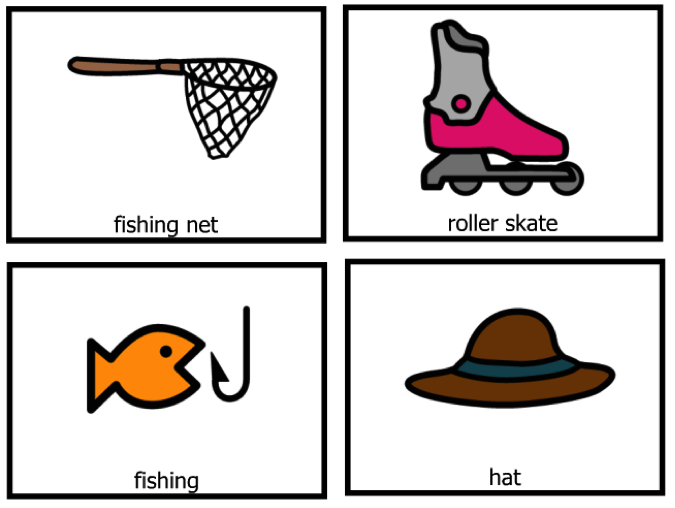
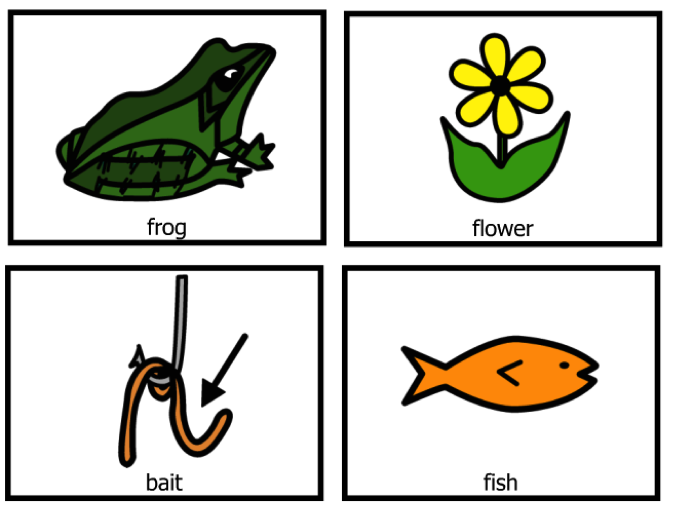
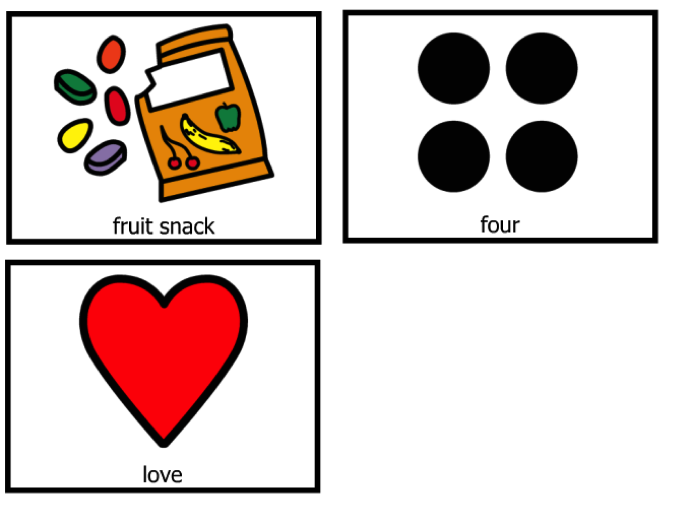
The picture symbols above have not been adapted for students with CVI (Cortical Visual Impairment).
The first symbols I chose were a bear and a hare. I changed the coloring on the rabbit so that it would have a higher contrast. Next, I had the fishing rod and fishing net. I changed the colors on both of these symbols. I have symbols for the roller skate, hat, frog, and fish that Bear caught. Next, symbols for the items that Hare is entertaining himself with while Bear fishes, a flower, bait and a snack. I chose to do a symbol for love as well as fishing. One of the questions that I wanted my students to be able to answer was “how many things did Bear catch in all?” so I also included a symbol to represent 4 objects total.
Picture Communication Symbols: Questions
- Who is the story about?
- What activity were Bear and Hare doing?
- How did Bear feel about fishing?
- What does Bear use to fish?
- Who fished the most?
- What did Bear “fish” first?
- Whose hat did Bear catch?
- What did Bear catch after the hat?
- What did Bear catch after the frog?
- What is the last thing Bear “fishes”?
- How many things did Bear catch in all?
- Where do you go fishing?
Tactile Communication Symbols
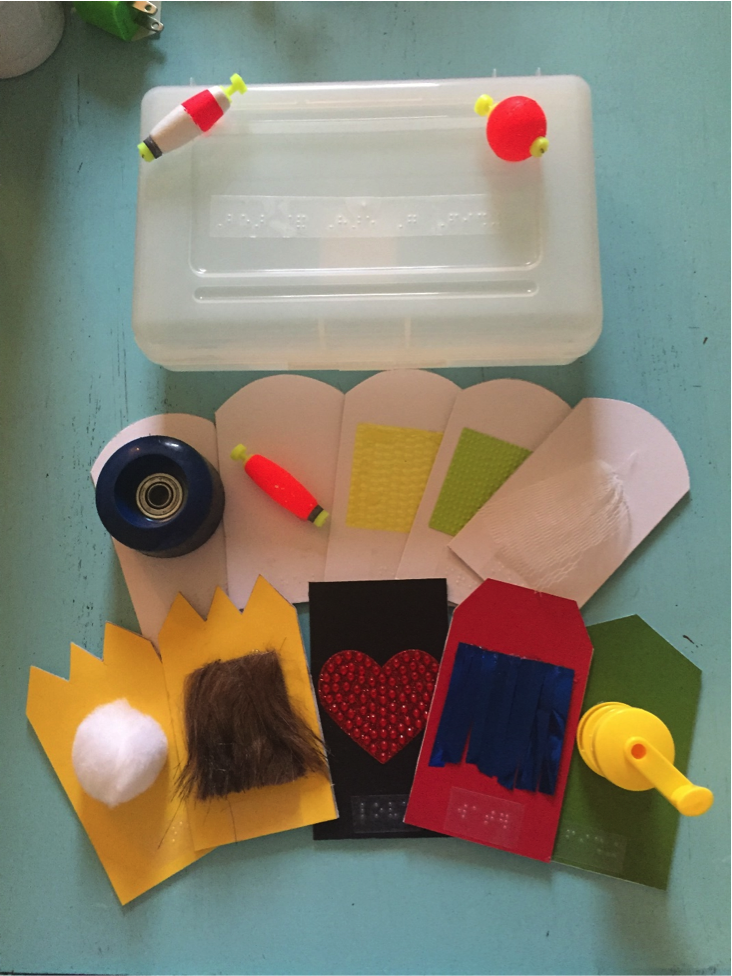 The symbols that I chose correspond with the objects in my story box for the book “Bear & Hare Go Fishing” by Emily Garvett. I have mounted the objects to matting board of different colors as well as distinct shapes for different categories. The cards have a braille label on them naming what the object represents. All of my communication cards are stored in a clear box with some fun fishing lure embellishments.
The symbols that I chose correspond with the objects in my story box for the book “Bear & Hare Go Fishing” by Emily Garvett. I have mounted the objects to matting board of different colors as well as distinct shapes for different categories. The cards have a braille label on them naming what the object represents. All of my communication cards are stored in a clear box with some fun fishing lure embellishments.
For people, I have a yellow card with a “crown” shape. I have two “people” in the book, Bear, who is represented by some brown fur and Hare, who is represented by a white pom-pom. The next category is place and I used a red card with a “barn” shape. The place I wanted to represent was “water” or for where Bear and Hare are fishing. I used some Mylar streamers to represent the water.
The next category was expression and I used a black card with just a rectangle edge. On this card I have a heart shape which represents love. For the action category, I have a green card in a “house” shape. This card has a fishing reel on it for fishing. The last category that I have represented with my communication symbols is objects. This is a white card in a “bread” shape. I have five different objects represented. For the first, I have a fishing lure which represents Hare’s hat. The second is a piece of netting for the net. Next, a roller skate wheel stands for the roller skate. Last I have two different textured papers to represent the frog and fish.
A student would be able to use these communication symbols to answer questions, sequence the story and further explore the objects. All of my symbols reiterate concepts from the book, story box, Talking Book and the picture communication symbols. Some background knowledge of the story would be needed as well as knowledge of the story box items. If a student did not know braille they may need the object named or better explained to them since the labels are in Braille.
Tactile Communication Symbols: Questions
- Who went fishing?
- How did Bear feel about fishing?
- Whose hat did Bear catch?
- What did Bear “fish” first?
- What did Bear fish after the hat?
- What did Bear use to fish?
- What did Bear fish after the frog?
- What was the last thing Bear caught?
- Who fished the most?
- Where do you go fishing?
Talking Book Project
Some students may prefer to use a talking PowerPoint book to read along with the book, while listening to the audio version.
This talking book is based on Bear & Hare Go Fishing by Emily Garvett.
